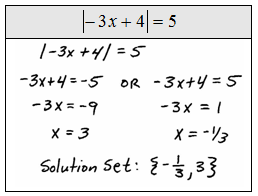In general,
Here n is a positive integer and X represents an algebraic expression called the argument of the absolute value. To solve these equations, set the argument equal to plus or minus n and solve the resulting equations.Instructional Video: Absolute Value Equations
Solve.
This technique requires us to first isolate the absolute value. Apply the usual steps for solving to obtain the absolute value alone on one side of the equation, and then set the argument to plus or minus n.
Solve.
When two absolute values are equal we can set the argument of one equal to the argument of the other.





























comment 0 التعليقات:
more_vertsentiment_satisfied Emoticon